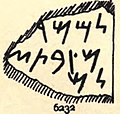Kition Necropolis Phoenician inscriptions

The Kition Necropolis Phoenician inscriptions are four Phoenician inscriptions discovered in the necropolis of Tourapi at Kition in 1894 by British archaeologist John Myres on behalf of the Cyprus Exploration Fund.
They currently reside in the British Museum, the Cyprus Museum and the Ashmolean Museum.[1][2][3]
They are dated to the 4th century BCE.[4]
The four inscriptions were first published in The Academy by George Albert Cooke, who later published the well known Text-book of North-Semitic Inscriptions (NSI) which included two of the inscriptions as NSI 21 and NSI 22.
British Museum inscription[]
The inscription in the British Museum, known as BM 125082, and the inscription as KAI 34, is a white marble funeral stela with a rectangular shaft and triangular top. The inscription is in five lines.[5]
Gallery[]

Close up of the inscription in the British Museum (KAI 34, NSI 21)

Inscription in the Cyprus Museum (NSI 22, RES 1207)[6]

Inscription in the Cyprus Museum (RES 1208)[6]
External links[]
- Kition, Larnaca; French Archaeological Mission of Kition (dir. Sabine Fourrier), Alexandre Rabot, November 1, 2020
Notes[]
- ^ Cooke, George Albert (1896). Four Phoenician Inscriptions from Cyprus I. The Academy. J. Murray. p. 59.
- ^ Cooke, George Albert (1896). Four Phoenician Inscriptions from Cyprus II. The Academy. J. Murray. p. 80.
- ^ Frothingham, A., & Marquand, A. (1896). Archæological News. The American Journal of Archaeology and of the History of the Fine Arts, 11(1), 62-144. doi:10.2307/496535
- ^ Myres, J. (1897). Excavations in Cyprus in 1894. The Journal of Hellenic Studies, 17, 134-173. doi:10.2307/623823
- ^ BM 125082
- ^ a b Honeyman, A. M. “The Phoenician Inscriptions of the Cyprus Museum.” Iraq 6, no. 2 (1939): 104–8. https://doi.org/10.2307/4241651
- 1885 archaeological discoveries
- Phoenician inscriptions
- Archaeological artifacts
- Phoenician steles


